Chemicals
As stated by Moline et al [Moline JM, et al.,(2000). Environ Health Perspect. 108:803-13.] paternal exposure to solvents, pesticides, and metals has been associated in animals and humans with the occurrence of spontaneous abortion, low birth weight, birth defects, childhood leukemia, brain cancer, change in the male-female sex ratio of offspring, and other end points related to growth and development. Certain paternal occupations - rubber, petroleum, and agricultural- chemical workers, painter, welder and janitor have been particularly implicated as detrimental to the reproductive health of men.
What makes the male particularly susceptible to toxin-induced damage is that, in contrast to the female ovary, the testis is characterized by a very high rate of cell proliferation with millions of sperm produced daily. Furthermore, the precursor stem cells undergo highly complex cell differentiation with specific steps known to be highly susceptible to certain types of chemical exposures.
Among the most well known toxicants to produce negative effects on sperm DNA are DDT and PCB (Hauser R. (2006) The environment and male infertility: recent research on emerging chemicals and semen quality. Semin Reprod Med vol 24 156-157].pesticide (Swan SH, Kruse RL, Liu F, Barr DB, Drobnis EZ, Redmon JB, Wang C, Brazil C, Overstreet JW; Study for Future Families Research Group. (2003) Semen quality in relation to biomarkers of pesticide exposure. Environ Health Perspect. Sep;111:1478-84] and herbicide (2, 4-D, alachlor and atrizine). Other chemicals, including styrene (used to make plastics, rubber and resins, chemical additives, self-care products and prescription medications, are suspect in causing sperm DNA damage.
Another potential source of environmental toxicants is phthalates which are used to improve flexibility in a variety of plastic like products. They are also found in nail polish, flooring, and adhesives and in an assortment of personal care products. Hauser et al. (Hauser R, Meeker JD, Singh NP, Silva MJ, Ryan L, Duty S, Calafat AM. (2007) DNA damage in human sperm is related to urinary levels of phthalate monoester and oxidative metabolites. Hum Reprod. 22(3):688-95) found a positive association for sperm DNA damage from exposure to monoethyl phthalate (MEP) in 379 men attending an infertility clinic. In pioneering studies, the SCSA test showed a very high correlation between dose of many toxicants and mouse sperm DNA fragmentation.
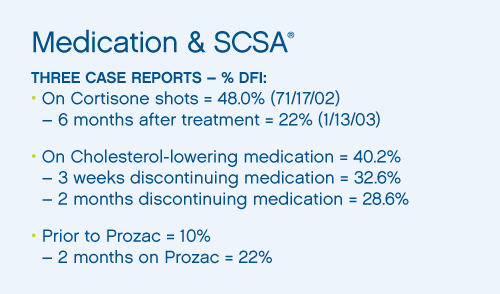
A recent study by Dr. Peter Schlegel's research group raised a major concern on sperm DNA fragmentation for men being prescribed anti-depressant SSRI's, in this case Paxil. Men who had an average %DFI (by Tunel assay) of 12% experienced a raise to 30% after two months on standard dosage medication. Given that data from Tunel and SCSA are close, but not necessarily the same, this 30% DFI is the threshold for clinical concerns. Thus, men on SSRI's should have an SCSA test to determine what their status is prior to attempting conception. With physician directives, men may go off of this medication while attempting natural conception, or, for freezing a number of semen samples to be used later. The %DFI should return to its level prior to the medication within a month or two.
Steroids. Steroids can interfere with proper development of healthy sperm. For example, cortisone shots (1) for e.g., back pain, can cause a major increase in sperm DNA fragmentation, well above the clinical threshold of 30%. Fortunately, this effect will come back to normal within a month or so; thus, wait at least this long prior to conception attempts, especially the costly IVF/ICSI procedures.
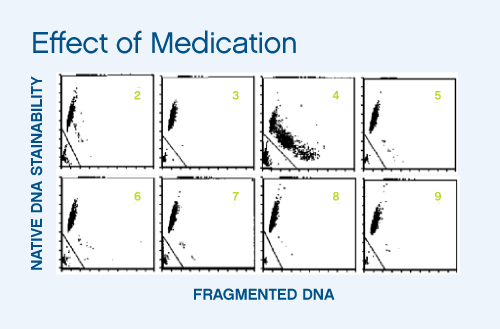
Radiation. Radiation that exposes the testis is negative for production of healthy sperm. In mouse model systems, doses as low as 25 rads caused a significant rise in SCSA defined % DFI.
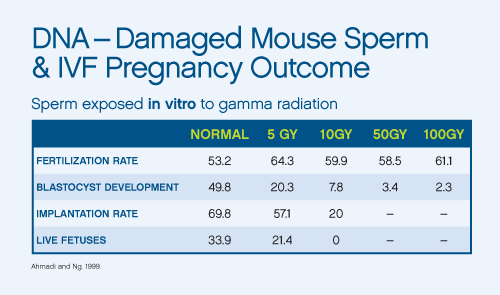
Mutagenic agents (agents that cause DNA mutations) have been shown to increase DNA fragmentation. These agents may be industrial chemicals, but also they are used to treat cancer patients with the hope that the mutagens will kill the cancer cells and cause as little damage to other body cells as possible. An example of an industrial chemical is methyl methanesulfonate. Sperm DNA fragmenation occured in all epidiymal mouse sperm by three days after exposure. Embryo death occurs from matings with males exposed to MMS; thus, the sperm with fragmented DNA fertilized the eggs and the embryo implanted. But the extensive DNA damage did not allow survival of the embryo.
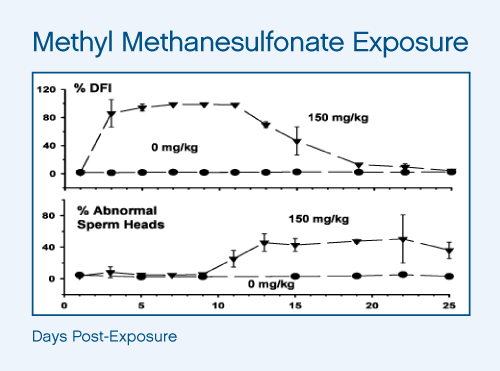
Exposure to certain pesticides may cause increased sperm DNA fragmentation. In Villa Juarez, State of Durango, Mexico nearly three-fourths of the agricultural men exposed to organophosphorus pesticides had DFI values greater than 30% (Sanchez-Pena et al. 2004).
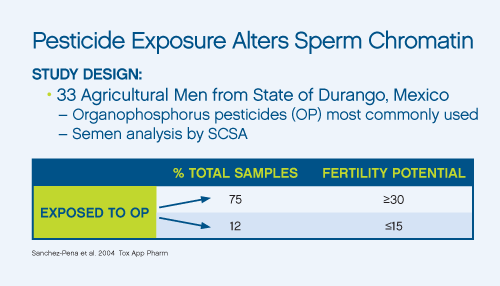
 PATIENT INFORMATION
PATIENT INFORMATION CLINIC INFORMATION
CLINIC INFORMATION

